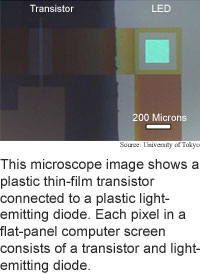
Plastic display circuit shines
Researchers developing inexpensive, large
flat-panel displays are looking for ways to combine organic, or plastic,
light emitting diodes and plastic thin film transistors.
Organic materials are cheaper and more flexible than the silicon
used in today's flat-panel displays, and have the potential to form transparent
screens.
Researchers from the University of Tokyo have taken a step forward
by fabricating on a glass surface a circuit that contains an organic light-emitting
diode and an organic thin-film transistor. The diode was bright enough
to be used in a display, according to the researchers.
The researchers' circuit was different from previous prototypes
because they made the transistors from pentacene, an organic material
with particularly good electrical properties.
The researchers' next steps are to find ways to more finely control
transistor performance, and to integrate many light emitting diodes into
a usable array of pixels.
The organic circuits could be used in practical displays in five
to ten years, according to the researchers. The work appeared in the October
20, 2003 issue of Applied Physics Letters.
Segway robot opens doors
Jolts turn liquid to solid
Switch promises optical chips
Physics tackles processor problem
Briefs:
Molecular memory is electric
Liquid crystal tunes fiber
Nanotubes fortify plastic film
Plastic display circuit shines
Model leverages nano tethers
Stamp forms organic laser

Research Watch blog
View from the High Ground Q&A
How It Works
RSS Feeds:
News
Ad links:
Buy an ad link
Ad links: Clear History
Buy an ad link
|
TRN
Newswire and Headline Feeds for Web sites
|
© Copyright Technology Research News, LLC 2000-2010. All rights reserved.